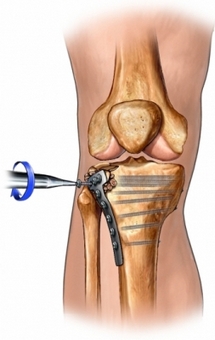Treatment of fractures – open reduction – Open mapping bones
Description open reduction bones
Reposition held, to return a broken bone its correct position. An open fracture reduction involves a skin incision, to get to the bones and the right arrange them. The procedure is used, If the bone is fragmented into many pieces and it is difficult to recover with the help of closed reduction. To connect and hold in place the fragments may be necessary screws and plates.
Reasons for open reduction bones
Open reduction is performed for the following reasons:
- To the bone has healed properly and quickly;
- To reduce pain and prevent further deformation;
- To restore normal bone and limb.
Possible complications of open reposition bones
Complications are rare, but no procedure does not guarantee the absence of risk. If you plan to restore the broken bone, you need to know about possible complications, which may include:
- Nerve Damage;
- Infection;
- Bleeding;
- Particles of tissue from bone marrow or blood clots from the veins can enter the lungs;
- The need for additional surgery, if the bone does not heal;
- Reaction to anesthesia.
Factors, that may increase the risk of complications:
- Advanced age;
- Open fracture;
- Existing diseases;
- Diabetes;
- The use of steroids;
- Smoking.
We need to discuss these risks with your doctor before the procedure.
How is the open reduction bones?
Preparation for the procedure
Your doctor, probably, conduct or appoint the following:
- Physical examination;
- Roentgen – analysis, which uses radiation, to take a picture of structures in the body, especially bones;
- Splint for a broken bone, to reduce the risk of further injury.
In the run-up procedure:
- Consult your doctor about the drugs taken. A week before surgery you may be asked to stop taking some medicines:
- Aspirin or other anti-inflammatory drugs;
- Blood thinners, such as clopidogrel (Plaviks) or warfarin.
- With an open fracture can be treated with antibiotics;
- We need to organize a trip to the procedure and back. Besides, take care of the home care;
- On the eve of the procedure in the evening you can eat a light meal. Do not eat or drink anything after midnight.
Anesthesia
They can be used the following types of anesthesia:
- General anesthesia – blocks any pain and the patient support in a sleep state during operation. Administered intravenously in the arm or hand;
- Local anesthesia – anaesthetises body, during surgery, the patient is awake. It can be provided in the form of injections.
Procedure open reduction bones
The doctor makes an incision in the skin in the area of the fracture, to get to the bone fragments. Bone fragments will be placed in their normal position. Screws, plate with screws, or special rods can be used for bone fixation. After that, the doctor closes the incision sutures. In the area of operation is applied plaster, bus or dressing.

Immediately after treatment
Dr. prescribe X-rays, to ensure that the bone is in the correct position.
How long will open reposition bones?
Treatment time depends on the type and location of the fracture.
Open reposition bones – Will it hurt?
After the procedure you will feel pain. Doctor will prescribe painkillers to reduce pain and discomfort.
The average hospital stay after open matching bones
0-3 day (depending on the severity of the injury and speed recovery).
Care after open reduction bones
Home Care
When you return home, follow these steps:, to ensure the normal recovery:
- Place the injured arm or leg on a pillow. Raise them above the level of the heart;
- Gently move uninjured joints of the hands and feet;
- Keep the plaster cast, bus and dressing clean and dry;
- Wait, gypsum is completely cured, before you rely on the injured limb;
- Do not try to scratch under the plaster cast;
- Do not drive, until the doctor says it's safe;
- Change the bandage, as indicated by a physician;
- Ask the doctor, when it is safe to shower, bathe, or to expose the cut by water;
- Be sure to follow your doctor's instructions.
Small bones usually heal over 3-6 weeks. The healing of large bones will take more time.
Your doctor may prescribe you treatments by a physiotherapist. It helps to restore the normal functioning of the damaged parts of the body or limbs.
In some cases, you can return to daily activities within a few days, despite cash gypsum or bus.
Contact your doctor after open reduction bones
After returning home, you need to see a doctor, If the following symptoms:
- Severe or unusual pain, that does not go away after taking pain;
- Signs of infection, including fever and chills;
- Redness, edema, increased pain, bleeding or discharge from the incision;
- Cough, shortness of breath or chest pain;
- Numbness and / or tingling in the injured extremity;
- Loss of movement in the fingers or toes, or the injured arm or leg;
- Burning or tingling under the cast;
- Redness of the skin around the plaster;
- Constant itching under the cast;
- Cracks or stains on the plaster cast;
- Chalky white, blue or black fingers, Foot.
